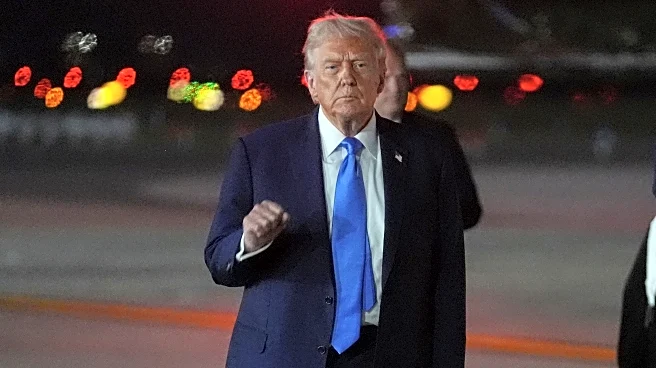What's Happening?
Gold prices have reached near-record highs, driven by expectations of further interest rate cuts by the U.S. Federal Reserve and ongoing geopolitical uncertainties. Spot gold was steady at $3,762.73 per ounce, following a record high of $3,790.82 earlier in the week. The Federal Reserve recently cut interest rates by 25 basis points, which has contributed to the rally in gold prices. Investors are anticipating additional rate cuts, with market participants pricing in two more 25-basis-point reductions by the end of the year. The geopolitical landscape, including tensions involving NATO and Russia, has further fueled demand for gold as a safe-haven asset. The dollar index rose, making dollar-priced bullion more expensive for holders of other currencies, yet the demand for gold remains strong.
Why It's Important?
The rise in gold prices highlights the impact of monetary policy and geopolitical tensions on financial markets. As a safe-haven asset, gold tends to perform well in environments characterized by low interest rates and economic uncertainty. The Federal Reserve's actions and the geopolitical climate are influencing investor behavior, with many seeking stability in gold amidst concerns over inflation and labor market weaknesses. This trend could have significant implications for U.S. economic stakeholders, including investors and policymakers, as they navigate the complexities of monetary policy and international relations. The potential for further rate cuts may continue to drive gold prices higher, affecting investment strategies and economic forecasts.
What's Next?
Investors are closely monitoring upcoming economic indicators, such as the U.S. Personal Consumption Expenditures index, for further insights into potential rate cuts. The Federal Reserve's future decisions will be pivotal in shaping market dynamics, with expectations of additional rate reductions influencing gold's trajectory. Geopolitical developments, particularly involving NATO and Russia, will also play a crucial role in determining safe-haven demand. Stakeholders, including financial analysts and policymakers, will need to assess the implications of these factors on the broader economy and investment strategies.
Beyond the Headlines
The current situation underscores the interconnectedness of monetary policy and geopolitical events in shaping market trends. The Federal Reserve's rate cuts reflect broader concerns about economic stability, while geopolitical tensions highlight the complexities of international relations. These developments may lead to long-term shifts in investment behavior, with increased focus on safe-haven assets like gold. Ethical considerations regarding the impact of monetary policy on economic inequality and the role of geopolitical strategies in global stability may also emerge as critical discussions.












